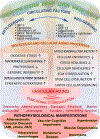Mechanisms of Vascular Aging
- PMID: 30355080
- PMCID: PMC6248882
- DOI: 10.1161/CIRCRESAHA.118.311378
Mechanisms of Vascular Aging
Abstract
Aging of the vasculature plays a central role in morbidity and mortality of older people. To develop novel treatments for amelioration of unsuccessful vascular aging and prevention of age-related vascular pathologies, it is essential to understand the cellular and functional changes that occur in the vasculature during aging. In this review, the pathophysiological roles of fundamental cellular and molecular mechanisms of aging, including oxidative stress, mitochondrial dysfunction, impaired resistance to molecular stressors, chronic low-grade inflammation, genomic instability, cellular senescence, epigenetic alterations, loss of protein homeostasis, deregulated nutrient sensing, and stem cell dysfunction in the vascular system are considered in terms of their contribution to the pathogenesis of both microvascular and macrovascular diseases associated with old age. The importance of progeronic and antigeronic circulating factors in relation to development of vascular aging phenotypes are discussed. Finally, future directions and opportunities to develop novel interventions to prevent/delay age-related vascular pathologies by targeting fundamental cellular and molecular aging processes are presented.
Keywords: atherosclerosis; inflammation; phenotype; proteostasis; stem cells.
Figures




References
-
- Health, United States, 2016: With Chartbook on Long-term Trends in Health Hyattsville (MD); 2017. - PubMed
-
- Heidenreich PA, Trogdon JG, Khavjou OA, Butler J, Dracup K, Ezekowitz MD, Finkelstein EA, Hong Y, Johnston SC, Khera A, Lloyd-Jones DM, Nelson SA, Nichol G, Orenstein D, Wilson PW, Woo YJ, American Heart Association Advocacy Coordinating C, Stroke C, Council on Cardiovascular R, Intervention, Council on Clinical C, Council on E, Prevention, Council on A, Thrombosis, Vascular B, Council on C, Critical C, Perioperative, Resuscitation, Council on Cardiovascular N, Council on the Kidney in Cardiovascular D, Council on Cardiovascular S, Anesthesia, Interdisciplinary Council on Quality of C and Outcomes R. Forecasting the future of cardiovascular disease in the United States: a policy statement from the American Heart Association. Circulation. 2011;123:933–44. - PubMed
-
- Lakatta EG and Levy D. Arterial and Cardiac Aging: Major Shareholders in Cardiovascular Disease Enterprises: Part I: Aging Arteries: A “Set Up” for Vascular Disease. Circulation. 2003;107:139–146. - PubMed
Publication types
MeSH terms
Substances
Grants and funding
- R44 AG053131/AG/NIA NIH HHS/United States
- R01 AG038747/AG/NIA NIH HHS/United States
- I01 BX002211/BX/BLRD VA/United States
- RF1 AG057964/AG/NIA NIH HHS/United States
- T32 AG052363/AG/NIA NIH HHS/United States
- R01 AG050238/AG/NIA NIH HHS/United States
- P30 AG013319/AG/NIA NIH HHS/United States
- R01 AG055395/AG/NIA NIH HHS/United States
- R21 AG055090/AG/NIA NIH HHS/United States
- R01 AG047879/AG/NIA NIH HHS/United States
- K02 AG045339/AG/NIA NIH HHS/United States
- R01 NS056218/NS/NINDS NIH HHS/United States
- R01 NS100782/NS/NINDS NIH HHS/United States
LinkOut - more resources
Full Text Sources
Other Literature Sources
Medical

